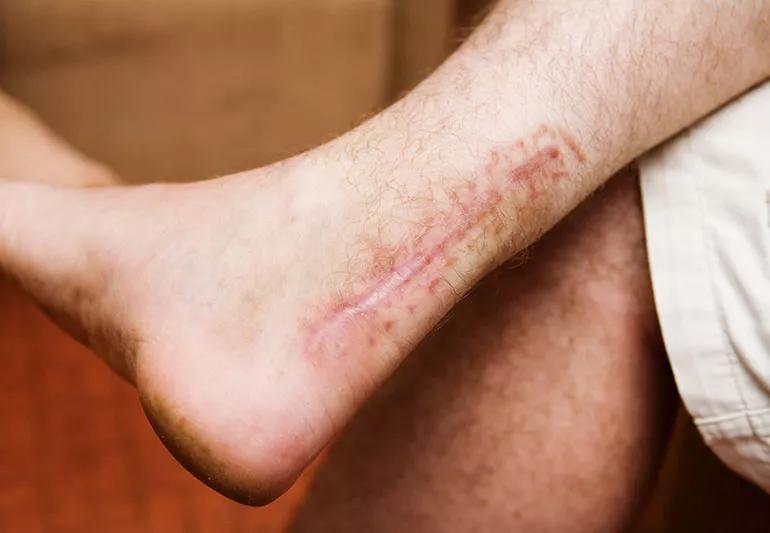Advertisement
Early wound maintenance goes a long way

From kitchen mishaps to skinned knees to surgical incisions, we all have scars with stories behind them — but most of us would rather our wounds heal without reminders of misfortunes past.
Advertisement
Cleveland Clinic is a non-profit academic medical center. Advertising on our site helps support our mission. We do not endorse non-Cleveland Clinic products or services. Policy
We talked to dermatologist Shilpi Khetarpal, MD, to find out what causes scarring and how to prevent a cut from turning into a scar.
Scars come from the tearing of the dermis, our lower level of skin, which is rich in collagen — the elastic fibers that keep our skin springy (among other bodily benefits). Scarring can happen after any injury to the dermis.
“Think of our normal collagen like a basket weave, very nice and even,” Dr. Khetarpal explains. “When we get a scar or injury to our skin, it triggers a wound-healing response that can create just enough collagen, not quite enough, or a little bit extra. It’s always going to be different than the initial skin you had in that area.”
Our bodies lose collagen as we age, which means elderly people are more prone to scarring than children. And whether a wound is likely to scar may depend on what part of your body you’ve injured — and how much blood is circulating to it.
“Your face and scalp tend to heal the fastest because we have the most circulation there,” Dr. Khetarpal says, “but a cut on your foot, where circulation isn’t as good, could take weeks to heal.”
Ideal scarring is minimal and light, but scars can take a variety of forms:
You’ve cut yourself. Now what? “We want to minimize inflammation or further trauma to the skin,” Dr. Khetarpal says. Here’s how to lessen your chances of scarring:
Advertisement
In summary, Dr. Khetarapal says, “The bottom line is don’t let it crust up, keep it moist, keep it clean, keep it covered, and minimize tension.”
Silicone scar sheets might help improve prevent new scars, but only if you use them in the first few weeks after an injury. And there’s no need to apply special, designated creams to your scars, either, Dr. Khetarpal says.
Instead, it’s the act of massaging that cream — or any simple, bland moisturizer — into a scarred area that can have the most impact on healing.
“In the first year, it’s important and has been shown to be helpful to do a gentle massage on your scar for a few minutes a day,” she says. “It helps break up any scar tissue for ones that are getting thick.”
The full scar remodeling process takes a year, during which time your scar may go through different phases of appearance: redder or darker, thicker or more textured. But once you hit the one-year mark, your scar is unlikely to change much on its own.
“After you’re beyond the one-year phase, topical medicines aren’t going to do anything,” Dr. Khetarpal warns.
In the past, you might’ve been told to let a wound heal for a year and then seek medical intervention if you’re not happy with the result. But Dr. Khetarapal says that guidance has changed; now, doctors can influence a scar’s healing by getting involved sooner rather than later.
“If someone is concerned with a scar — say, they’ve had surgery or a major trauma — the earlier we intervene, the better,” she says. “We can actually influence how a scar heals versus waiting for it to heal and then trying to make it better.”
You can explore scar-minimization options as early as a week after your injury (or as soon as your stitches are removed, if you have them). In-office procedures such as lasering and microneedling — which trigger a controlled wound response — can reduce the appearance of scars by 50-60%.
“We can’t erase it, but we can improve it,” Dr. Khetarpal says.
Advertisement
Learn more about our editorial process.
Advertisement

Moisturize often, take oatmeal baths, use Epsom salts and follow a healthy diet to help reduce your symptoms

Adding a little milk to your bath can leave your skin smooth, silky and refreshed

Wear properly fitted shoes, break them in ahead of time and wear moisture-wicking socks

Topical treatments — and even some cosmetic procedures — may help reduce the appearance of this crinkled-paper look

Ferulic acid can help make other antioxidant products more powerful

You’re putting your skin at risk of sunburn and even skin cancer when you pour on the beer

Mineral sunscreens have a heavier texture to create a physical barrier, while chemical sunscreens are lighter and use a chemical reaction to prevent UV damage

Deal with dry skin by preserving your skin’s moisture, using moisturizing products and taking preventive action

Focus on your body’s metabolic set point by eating healthy foods, making exercise a part of your routine and reducing stress

PFAS chemicals may make life easier — but they aren’t always so easy on the human body

While there’s little risk in trying this hair care treatment, there isn’t much science to back up the claims